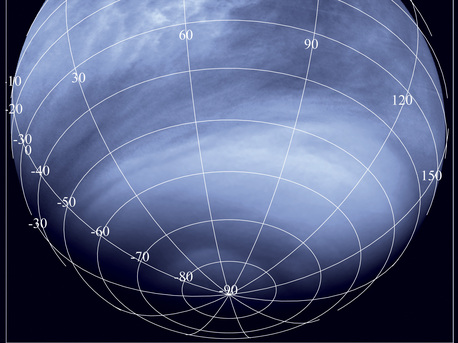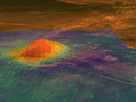Venus Express
Was Venus once a habitable planet?
 © ESA/MPS/DLR/IDA |
Venus Monitoring Camera image taken in the ultraviolet (0.365 micrometres), from a distance of about 30 000 km. It shows numerous high-contrast features, caused by an unknown chemical in the clouds that absorbs ultraviolet light, creating the bright and dark zones. With data from Venus Express, scientists have learnt that the equatorial areas on Venus that appear dark in ultraviolet light are regions of relatively high temperature, where intense convection brings up dark material from below. In contrast, the bright regions at mid-latitudes are areas where the temperature in the atmosphere decreases with depth. The temperature reaches a minimum at the cloud tops suppressing vertical mixing. This annulus of cold air, nicknamed the ‘cold collar’, appears as a bright band in the ultraviolet images.
- » 1 - Venus has lost large quantities of water
- » 2 - Was Venus once a waterworld?
- » 3 - Venus Express
Venus has lost large quantities of water
But underneath it all the two planets share a number of striking similarities. They are nearly identical in size and now, thanks to ESA’s Venus Express orbiter, planetary scientists are seeing other similarities too.
“The basic composition of Venus and Earth is very similar,” says Håkan Svedhem, ESA Venus Express Project Scientist. Just how similar planetary scientists from around the world will be discussing in Aussois, France, where they are gathering this week for a conference.
Venus Express
Was Venus once a habitable planet?
 © ESA/MPS/DLR/IDA |
Venus Monitoring Camera image taken in the ultraviolet (0.365 micrometres), from a distance of about 30 000 km. It shows numerous high-contrast features, caused by an unknown chemical in the clouds that absorbs ultraviolet light, creating the bright and dark zones. With data from Venus Express, scientists have learnt that the equatorial areas on Venus that appear dark in ultraviolet light are regions of relatively high temperature, where intense convection brings up dark material from below. In contrast, the bright regions at mid-latitudes are areas where the temperature in the atmosphere decreases with depth. The temperature reaches a minimum at the cloud tops suppressing vertical mixing. This annulus of cold air, nicknamed the ‘cold collar’, appears as a bright band in the ultraviolet images.
- » 1 - Venus has lost large quantities of water
- » 2 - Was Venus once a waterworld?
- » 3 - Venus Express
Venus has lost large quantities of water
But underneath it all the two planets share a number of striking similarities. They are nearly identical in size and now, thanks to ESA’s Venus Express orbiter, planetary scientists are seeing other similarities too.
“The basic composition of Venus and Earth is very similar,” says Håkan Svedhem, ESA Venus Express Project Scientist. Just how similar planetary scientists from around the world will be discussing in Aussois, France, where they are gathering this week for a conference.






